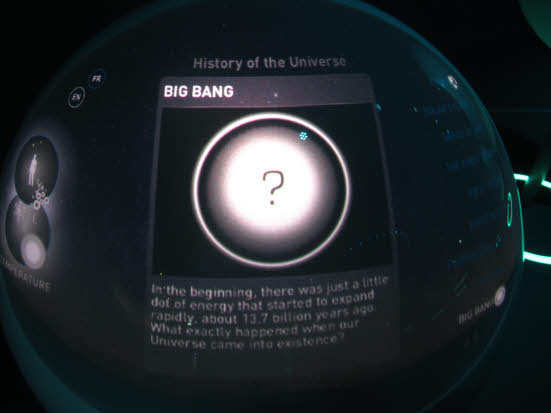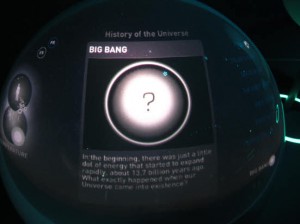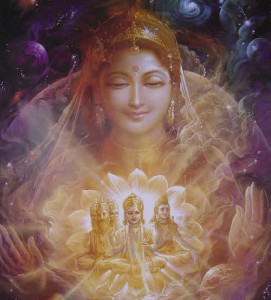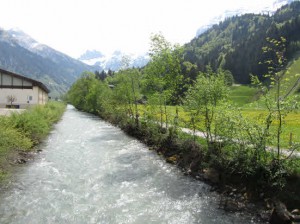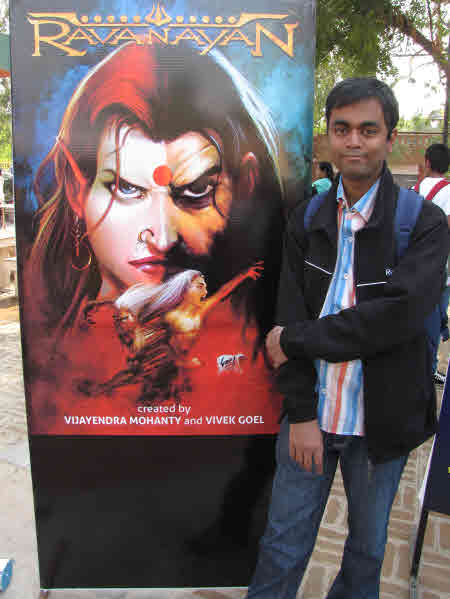Text and Pictures by Jai Chabria
[box]Jai Chabria meets an interesting man during a train journey. The conversation he has with him brings to light the man’s insight into various facets of the Indian culture. Meet the ordinary extra-Indian – as he wants to be referred to. Catch his breezy conversation with a fascinated Jai Chabria.[/box]Author’s note: I came across a very interesting person during a recent train journey. When I heard the discussion between him and his family members, I realised he had a very interesting perspective on what being Indian was all about in the context of Indian culture and its mythological heritage. On my request, he finally agreed to contribute to the pool of ideas that is ‘Spark,’ on the condition that he does not want to be named as any publicity will unsettle him; he wanted to be merely referred to as the ‘extra-Indian.’ Come with me on this extra-ordinary journey with the extra-Indian or E.I.
Further, we, as Indians, celebrate myths and beliefs and appreciate symbols, illustrations and colours that bring them alive for us. My photographs here are pictorial representations of what I took away from the conversation with E.I. I begin with the hope that this will make you understand the journey better.
Why do you wish to be called ‘extra-Indian’? What does it mean?
E.I: It is not that I wish to be called so. I’m already being called so by my family and friends. Whenever they are in doubt and need advice, which is very often, they approach me humbly asking what path they should take. I explain what the Indian culture of right thought, word and conduct is, and they choose the path that is most suited to that philosophy. But in happier times, they are always calling me ‘extra-Indian,’saying things like, “Grandpa, don’t get over-involved in your Indian-ness philosophy. Why don’t you be cool and chilled out like the rest of us? We’re all Indians too. You’re just unnecessarily being extra Indian.”
We share a good laugh.
So what is it you have done to deserve that title?
E.I: Actually, I have not done anything brand new or different. It’s just that these new generations come and think I’m deliberately being old. (Laughs) I’m just an ordinary Indian from my time.
Okay, could you just share with us some of those bits you were discussing with your family some time back. I’m not sure I’ve heard anything similar before.
E.I: Okay. Our discussion was about some chief similarities in the holy texts of our Indian way called Sanatana Dharma, and the Holy Bible. For instance, in the Ramayan compiled by Sage Vyasa, Ravana approaches Sita with humility. When Sita is in Ashoka Vana, Ravana comes frequently to pay his respects, and treats Sita as the Holy Mother. He undertakes the entire exercise of Sita-haran or the abduction of Sita, to serve just one purpose – to meet Rama, and be given freedom from the cycle of birth and death. But meeting Rama cannot happen without the involvement of Sita. So Sita, plays a very central role in the text.
Coming to the Holy Bible, Mother Mary is a perpetual visible or invisible presence in Christ’s life. She’s the foundation. Her strength and support arethe ever-present background to all efforts undertaken by Christ for the service of humanity. It’s as if Christ draws His very strength from Her. And Christ wishes to meet His Holy Father one day, but not without having performed all His earthly duties towards humankind, which in turn, is made possible by the determined and unfailing support of Mother Mary, the Holy Mother.
So, we see that just a male-dominated or female-dominated path does not lead to the Absolute. Both principles are required equally in order to be successful.
Very interesting. What about Sage Valmiki’s Ramayana?
E.I: Sage Valmiki has depicted Ravana’s approach toward Sita as rash. But, we see that whatever be the approach, there is no way for Ravana (or the seeker, the student in search of the End or Absolute shown as Rama) to complete the journey and escape the cycle of birth and death, without the grace of Mother Sita (he later explains Her role). It’s not that I’m being preachy about this point as my family accuses me of being, sometimes. But I do believe those who’ve not figured this out, will surely do so in some birth of theirs. As it happens, even I’m not sure how many births I’ve used up to figure this one out. (Laughs modestly)
E.I: You have any more questions for me? (Smiles)
me: Yes, actually, why don’t you tell me something about our culture. (I notice his grand old face is aglow with a knowing smile!)
E.I: See son, when we speak of Indian culture, we need to remember that it is a confluence of all cultures. But again, India opened her doors and hearts to all cultures and peoples because of her unshakeable faith in her own inner culture and its eternal nature. So, if you’re asking what is ‘perceived’ Indian culture, my young grand-children here will be able to give you a good idea of that. If you’re asking about our unchanging inner Indian culture based on belief systems handed down through the ages, I’ll have to go back to the very beginning of creation to even attempt an answer.
What I have learned from my Guru-parampara or Teacher-disciple lineage is that there is one thing which we call THAT. We believe everything originates from THAT and dissolves in THAT. It is what you may call as the Supreme Being or God or Eternal Intelligent Power. Now, if you look around, you’ll see the food chain – plant eats minerals in the soil, rat eats pulses from the plant, snake eats rat, eagle eats snake – everything has been made in a hierarchical pattern. We believe the structure is the same for the created worlds – Insect world, Animal world, Human world, and so on in the hierarchy leading right up to the One seated right on top of the chain.
me: This is quite fascinating. Okay, and then..
E.I: Usually, when we observe we see that in the human world, the creator of any object or institution comes first. After he creates, comes the next one, the one who keeps it running. Last, comes the one who causes the object’s destruction and that one is either feared or condemned.
Now, what we feel is beyond the human world, we call as divine, admitting that IT is beyond our power to comprehend. Why is it difficult for the human mind to comprehend the divine? It is because the divine operates on the exact opposite of human principles. To state an example, for the human, the idea of birth is great, but death is bad. For the divine, the idea of birth in the human world of suffering and fear, leaving IT’s bliss behind, is bad. Death or release from the bondage of the human world and the return to IT’s divine bliss, is great.
In a similar manner, if we start from the THAT, and count down in order of birth, we see that in our idea of the divine, the role of Destroyer is foremost. It is the One that helps remove the external trappings of the manifested world and thus, helps become the Essence which is THAT. That is why, in order of hierarchy, It must have been the first to have been born from the THAT, having to remain and maintain the principle which is closest to being the THAT. That is why we call the Destroyer or Destructive Principle as Aadi, the First One or First Born, and recognise It as the One upholding the Highest Principle of Silence and Stillness, which will help reach the THAT. It is considered most important.
Next in order of birth and importance is the role of Sustainer or Preserver. It is the One that is an offshoot of the Destroyer, the One that will sustain what is going to come next while upholding at Its core the higher principle of renunciation, which will help reach the Destroyer, which in turn will help reach the THAT. Because It sustains and preserves while It exists and in order of hierarchy of birth, comes between the Destroyer and what It itself is going to create next – the Creator, It is called Ananth, the One without an end. Middle, as you see, has no end, as It is the Middle.
Then comes the role of Creator, which is an offshoot of the Sustainer. The pictorial depiction too shows the Creator seated in a lotus, the stalk of which is seen emerging from the navel of the Sustainer – who in turn, is seen reclining in a peaceful position. The stalk resembles the umbilical chord, the lotus in bloom symbolises the crown chakra of the Sustainer. According to ancient Indian medical science, chakras are vortices of energy, and a unique chakra corresponds to each of our different organ systems. The highest chakra placed near the crown of the head is depicted as a thousand-petalled lotus, symbolising supreme knowledge. Not surprisingly, this chakra is also called Brahma-randhra or the chamber of Brahma – the Creator. In addition, in human beings, the chakra corresponding to the creative system is placed near the lowest. In the divine, it is opposite. The role of the Creator is to remain rooted in the lotus or awareness of the supreme knowledge of Unity which is THAT; but to create diverse beings, principles, ideas and meanings which will operate at lower levels of clarity ignorant of their divine Unity. The Creator’s job is to also encode a binding factor common to all beings, which if realized, will help those beings reach the higher levels in the hierarchy, which will finally lead them to and culminate their search in THAT.
And of course, our depiction of the Holy Mother through the ages – Mother Sita, Mother Parvathi, Mother Durga, Lakshmi and Saraswati, are all different aspects of the same Holy Mother. Just as the different principles we spoke about earlier, they are different aspects of the same THAT. SHE is the symbol of the Creative Principle and Creative Power of THAT and coming down the hierarchy, of each and every principle we have just spoken about, which is why we call IT the Mother or Feminine Principle. Without HER, no principle can function and no creation will be possible. That is why, SHE is called Aadi Para-Shakthi or the First Supreme Super-Power,as it is this Creative Principle that gave rise to the Trinity and the rest of the entire hierarchy of creation. So, HER grace is required for anything and everything – to emerge from THAT as well as to return to THAT. Because to return to THAT, one needs to somehow reach the Destroyer, and the Destroyer, like any other manifested principle, cannot function without Its Creative Principle. So call out to HER, surrender to HER, like the devoted Ravana, and wait patiently for Rama to come.. Happy Navratri!
Saying this, the extra-Indian gathers his bags and gets up from his seat next to the open window. He turns around to face me and says, ‘Remember my boy, there is no rush to understand anything. The river was made to flow into the sea. It will. One day all rivers, irrespective of name, religion, caste, which state they come from, rich or poor etc., will flow and merge in that Sea which unites all diversity. I am merely one among those multitudes of rivers and am just trying to understand my world from books and wise words my country has kept alive for centuries. Whether I manage to understand or fail to understand, I am glad and relieved that one day You and I are definitely going to flow gracefully into that Sea of Supreme Truth, Consciousness and Bliss.”
I accompany him to the door. As we wait for the train to slow down at the station, I can’t help but ask my last question.
me: You said we as the rivers will surely flow into the Sea which is THAT. Then, if it is going to happen anyway, why at all are we trying to understand anything?
E.I looks suddenly lost like a child denied a chocolate and waiting in hope.
He finally answers as the train slows to a stop.
E.I: Some of us are looking for something which does not meet the description of anything our worlds have given us. We are looking for that uniting factor beneath all this diversity we see.
See son, look outside. We are moving towards the station, but it can also be seen as though the station is approaching us.Some of us are foolish enough not to wait until the time we flow into the Sea. We try to find and surrender to that Holy Mother, which is common to all and dearest to that Sea. And we live in hope, that the unthinkable will happen..that the Sea will reach out to gather us and merge us into IT’s everlasting BLISS.
He alights with his bags and the unthinkable happens. I find myself calling out to him, “Sir, how do I find HER?”
He turns around smiling that knowing smile again, his eyes gleaming. He commands, “Leave all fears aside. Just call out to HER, ‘Mother…Mother…Mother..’ SHE will come if your heart is true. That is how I found HER too. SHE may manifest in any form – sudden intuitive powers, sudden eloquence in a language which is not your native tongue, new-found artistic abilities..in a way that you will know something brand new and powerful is with you. As for me now, the wait is on.” He shakes hands, smiles a winning smile and disappears into the crowd.
What an amazing journey and what an Indian! Creative Principle..? Could all this be true?..I ask myself. Just then, I become aware of a tingling in the hand he just shook moments ago.. like electrical energy in repeated waves flowing continuously for several minutes. Dear readers, none of all the science I am so fond of, and my head is so full with, can help me find words to explain this feeling to you. But I understand. I had asked a question after his departure and yet, the question had been answered. From the doorway of my compartment, I desperately scan the crowd rushing towards the station’s exit, but I can’t find E.I. All that I now know is that new questions have replaced all the old answers in my head. This is that extraordinary journey that has just ended. But a new one to find those answers has just begun. Goodbye readers, hope you enjoyed travelling with us. And, Thank You E.I – I hope the Station comes to get you soon!
Jai Chabria is one amongst a rare tribe of media-shy media professionals. When faced with a camera, he prefers to shock the photographer by running right round behind it. He is one of those who believe in their right to remain undiscovered and undescribed in any manner. This might shock him for, if a picture is worth a thousand words, then this hunter just got hunted and got captured in nineteen thousand.
[button link=”https://sparkthemagazine.com/wp-content/uploads/2011/10/spark-oct2011.pdf” color=”orange” newwindow=”yes”] Click here to download the October 2011 issue as a PDF![/button] [button link=”http://issuu.com/sparkeditor/docs/spark-oct2011?mode=embed&layout=http%3A%2F%2Fskin.issuu.com%2Fv%2Fcolor%2Flayout.xml&backgroundColor=000000&showFlipBtn=true” color=”red” newwindow=”yes”] Click here to flip and read the issue like a magazine[/button]
[facebook]share[/facebook] [retweet]tweet[/retweet]

